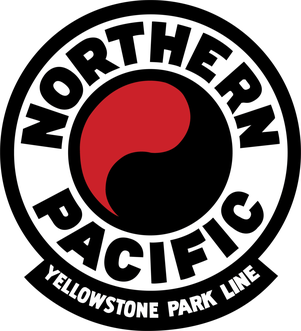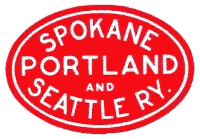
Kalama (ka-LAM-ma) is a city in Cowlitz County, Washington, United States. It is part of the Longview, Washington Metropolitan Statistical Area. The population was 2,959 as of the 2020 census.

The Great Northern Railway was an American Class I railroad. Running from Saint Paul, Minnesota, to Seattle, Washington, it was the creation of 19th-century railroad entrepreneur James J. Hill and was developed from the Saint Paul & Pacific Railroad. The Great Northern's route was the northernmost transcontinental railroad route in the U.S.

The Seattle and Walla Walla Railroad was a 3 ft narrow gauge railroad and was the first proper railroad to serve Seattle, Washington, preceded only by horse-drawn rail vehicles and by a coal train making the very short haul from Lake Union to Pike Street. Despite its ambitious name, actual construction never went beyond King County, the county of which Seattle itself is the seat. After being sold to Henry Villard's Oregon Improvement Company in 1880 it was renamed the Columbia and Puget Sound Railroad. In 1916, that became the Pacific Coast Railroad Company.
The Seattle, Lake Shore and Eastern Railway (SLS&E) was a railroad founded in Seattle, Washington, on April 28, 1885, with three tiers of purposes: Build and run the initial line to the town of Ballard, bring immediate results and returns to investors; exploit resources east in the valleys, foothills, Cascade Range, and Eastern Washington in 19th-century style, attracting more venture capital; and boost a link to a transcontinental railroad for Seattle, the ultimate prize for incorporation. The historical accomplishment of the line was Seattle to Sumas at the border, with British Columbia, Canada, connecting with the Canadian Pacific transcontinental at the border at Huntingdon, British Columbia, now part of the City of Abbotsford.

The Northern Pacific Railway was an important transcontinental railroad that operated across the northern tier of the western United States, from Minnesota to the Pacific Northwest. It was approved and chartered in 1864 by the 38th Congress of the United States in the national / federal capital of Washington, D.C., during the last years of the American Civil War (1861-1865), and given nearly 40 million acres of adjacent land grants, which it used to raise additional money in Europe, for construction funding.

The Spokane, Portland & Seattle Railway was a railroad in the northwest United States. Incorporated in 1905, it was a joint venture by the Great Northern Railway and the Northern Pacific Railway to build a railroad along the north bank of the Columbia River. The railroad later built or acquired other routes in Oregon. The SP&S was merged into the Burlington Northern in March, 1970. Remnants of the line are currently operated by BNSF Railway and the Portland and Western Railroad.

The North Coast Limited was a named passenger train operated by the Northern Pacific Railway between Chicago and Seattle via Bismarck, North Dakota. It started on April 29, 1900, and continued as a Burlington Northern Railroad train after the merger on March 2, 1970 with Great Northern Railway and the Chicago, Burlington and Quincy Railroad. The next year, it ceased operations after the trains which left their originating stations on April 30, 1971, the day before Amtrak began service, arrived at their destinations.
The Ilwaco Railway and Navigation Company operated a 3 ft narrow gauge railroad that ran for over forty years from the bar of the Columbia River up the Long Beach Peninsula to Nahcotta, Washington, on Willapa Bay. The line ran entirely in Pacific County, Washington, and had no connection to any outside rail line. The railroad had a number of nicknames, including the "Clamshell Railroad" and the "Irregular, Rambling and Never-Get-There Railroad."
Historic ferries in Oregon are water transport ferries that operated in Oregon Country, Oregon Territory, and the state of Oregon, United States. These ferries allowed people to cross bodies of water, mainly rivers such as the Willamette in the Willamette Valley, and the Columbia, in order to transport goods, move people, and further communications until permanent bridges were built to allow faster crossing of the water. The early ferries were used by wagons and pedestrians, while later ones transported trains and then automobiles. Oregon has a few automobile ferries still in operation.
Rail transportation is an important element of the transportation network in the U.S. state of Oregon. Rail transportation has existed in Oregon in some form since 1855, and the state was a pioneer in development of electric railway systems. While the automobile has displaced many uses of rail in the state, rail remains a key means of moving passengers and freight, both within the state and to points beyond its borders.

The Bailey Gatzert was a sternwheel steamboat that ran on the Columbia River and Puget Sound, in Washington state, US, from the 1890s to the 1920s. This vessel was considered one of the finest of its time. It was named after Bailey Gatzert, an early businessman and mayor of Seattle, who was one of the closest friends and business associates of John Leary – the person who financed the ship.

Yaquina Bay, like Coos Bay, is a shallow coastal bay on the Oregon Coast in the Pacific Northwest of North America. The principal town on Yaquina Bay is Newport, Oregon. The Yaquina River flows into the bay. Until modern roads reached Newport in the late 1920s, the principal transportation method to and from Newport was by ship or boat.

The sidewheeler Idaho was a steamboat that ran on the Columbia River and Puget Sound from 1860 to 1898. There is some confusion as to the origins of the name; many historians have proposed it is the inspiration for the name of the State of Idaho. Considerable doubt has been cast on this due to the fact that it is unclear if the boat was named before or after the idea of 'Idaho' as a territory name was proposed. John Ruckel also allegedly stated he had named the boat after a Native American term meaning 'Gem of the Mountains' he got from a mining friend from what is now Colorado territory. This steamer should not be confused with the many other vessels of the same name, including the sternwheeler Idaho built in 1903 for service on Lake Coeur d'Alene and the steamship Idaho of the Pacific Coast Steamship Line which sank near Port Townsend, Washington.

The Pacific Northwest Corridor or the Pacific Northwest Rail Corridor is one of eleven federally designated higher-speed rail corridors in the United States and Canada. The 466-mile (750 km) corridor extends from Eugene, Oregon, to Vancouver, British Columbia, via Portland, Oregon and Seattle, Washington, in the Pacific Northwest region. It was designated a high-speed rail corridor on October 20, 1992, as the one of five high-speed corridors in the Intermodal Surface Transportation Efficiency Act of 1991 (ISTEA).
The Puget Sound Shore Railroad and successor Northern Pacific and Puget Sound Shore Railroad built a branch line of the Northern Pacific Railroad between Puyallup and Seattle, Washington, U.S., and partially constructed a line around the east side of Lake Washington to Woodinville.
The history of rail in Oregon predates the transcontinental railroad in 1869.

Ocean Wave was a steamboat that was operated from 1891 to 1897 on the Columbia River, from 1897 to 1899 on Puget Sound and from 1899 to 1911 as a ferry on San Francisco Bay. Ocean Wave is perhaps best known for transporting summer vacationers from Portland, Oregon to seaside resorts near Ilwaco, Washington during its service on the Columbia River. This vessel is also known for being the first ferry placed in service by the Atchison, Topeka and Santa Fe Railway.

Emma Hayward commonly called the Hayward, was a steamboat that served in the Pacific Northwest. This vessel was once one of the finest and fastest steamboats on the Columbia River and Puget Sound. As newer vessels came into service, Emma Hayward was relegated to secondary roles, and, by 1891, was converted into a Columbia river tow boat.

Elwood was a sternwheel steamboat which was built to operate on the Willamette River, in Oregon, but which later operated on the Lewis River in Washington, the Stikine River in Canada, and on Puget Sound. The name of this vessel is sometimes seen spelled "Ellwood". Elwood is probably best known for an incident in 1893, when it was approaching the Madison Street Bridge over the Willamette River in Portland, Oregon. The bridge swung open to allow the steamer to pass. However, a streetcar coming in from the east end of the bridge failed to notice the bridge was open, and ran off into the river in the Madison Street Bridge disaster.

Harvest Queen was the name of two stern-wheel steamboat built and operated in Oregon. Both vessels were well known in their day and had reputations for speed, power, and efficiency.The first Harvest Queen, widely considered one of the finest steamers of its day, was constructed at Celilo, Oregon, which was then separated from the other portions of the navigable Columbia River by two stretches of difficult to pass rapids.

















